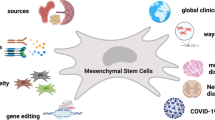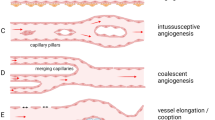Abstract
The thin extracellular matrix that is found basally in epithelial and endothelial cells and around smooth muscle, peripheral nerves, and fat cells is known as the basement membrane. A murine tumor matrix extract, termed Matrigel, has provided an abundant source of basement membrane proteins (laminin, collagen IV, heparan sulfate, etc.). Matrigel gels at room temperature into a structure similar to the authentic matrix. Embryonic tissue explants, stem cells, and various cell types differentiate when cultured on Matrigel. Matrigel has been used in various in vitro assays for angiogenesis, cell invasion, spheroid formation, organoid formation from a single cell, etc. In vivo Matrigel improves/promotes tumor xenograft growth and is used to measure angiogenesis, improve heart and spinal cord repair, increase tissue transplant take, etc. Endothelial cells plated on top of Matrigel form capillary-like tubules. The gene for thymosin beta 4 was induced at 4 h after plating endothelial cells on Matrigel, and when the thymosin beta 4 protein was added exogenously to the culture, tubule formation was accelerated. Thymosin beta 4, a small 43 kDa protein present in all body fluids and cells, has multiple biological activities, including reducing inflammation, apoptosis, and cytotoxicity while increasing cell migration, stem cell recruitment and differentiation, and tissue repair. Thymosin beta 4 was subsequently found to promote angiogenesis in vivo and to improve dermal and ocular healing in experimental injury models. It has regenerative activity in animal models of traumatic brain injury, stroke, multiple sclerosis, heart attack, peripheral neuropathy, liver and kidney fibrosis, and hair growth. Clinical trials have demonstrated its efficacy for both stasis and pressure ulcers and for both dry eye and a rare ocular disease. This mini review will discuss the development of Matrigel and the discovery of thymosin beta 4 as a regenerative protein that is upregulated when endothelial cells are plated on Matrigel.

Similar content being viewed by others
References
Benton G, Arnaoutova I, George J, Kleinman HK, Koblinski J (2016) Matrigel: from discovery and ECM mimicry to assays and models for cancer research. Adv Drug Discov Rev 79–80:3–18
Kleinman HK, McGarvey ML, Hassell JR, Star VL, Cannon FB, Laurie GW, Martin GR (1986) Basement membrane complexes with biological activity. Biochemistry 25:312–318
Benton G, Kleinman HK, George J, Arnaoutova I (2012) Multiple uses of basement membrane-like matrix (BME/Matrigel) in vitro and in vivo with tumor cells. Int J Cancer 128:1751–1757
Arnaoutova I, George J, Kleinman HK, Benton G (2012) Basement membrane (BME) has multiple uses with stem cells. Stem Cell Rep Rev 8:163–169
Kubota Y, Kleinman HK, Martin GR, Lawley TJ (1988) Role of laminin and basement membrane in the differentiation of human endothelial cells into capillary-like structures. J Cell Biol 107:1589–1597
Benton G, George J, Kleinman HK, Arnaoutova (2009) Advancing science and technology via 3D culture on basement membrane matrix. J Cell Physiol 221:18–25
Themistoceous GS, Katapodois H, Sourla A, Lembessis P, Doillon CJ, Soucacos PN, Koutsilieris M (2004) Three-dimensional type I collagen cell culture systems for the study of bone pathophysiology. In Vivo 18:687–696
Kleinman HK, Klebe RJ, Martin GR (1981) Role of collagenous matrices in the adhesion and growth of cell. J Cell Biol 88:473–485
Hoffman MO, Kibbey MC, Letterio JJ, Kleinman HK (1996) Role of laminin-1 and TGF-beta 3 in acinar differentiation of a human submandibular gland cell line (HSG). J Cell Sci 109:2013–2021
Pasquier J, Gupta R, Bioult D, Hoarau-Vechot J, Courjaret R, Machaca K, Al Suwaidi J, Stanley EG, Fafii EG, Da Elliott, Abi Khalil C, Rafii A (2017) Coculturing with endothelial cells promotes in vitro maturation and electrical coupling of human embryonic stem cell-derive cardiomyocytes. J Heart Lung Transplant 36:684–693
Bissell MJ, Ran TG (1999) Regulation of functional cytodifferentiation and histogenesis in mammary epithelial cells: role of the extracellular matrix. Environ Health Perspect 80:61–70
Gho YS, Kleinman HK, Sosne G (1999) Angiogenic activity of human soluble intercellular adhesion molecule-1. Cancer Res 59:5128–5132
Carey DJ, Todd MS, Rafferty CM (1986) Schwann cell myelination: induction by exogenous basement membrane-like extracellular matrix. J Cell Biol 102:2254–2263
Hauser BR, Hoffman MP (2015) Regulatory mechanisms driving salivary gland organogenesis. Curr Top Dev Biol 115:111–130
Barkan D, Kleinman HK, Simmons JL, Asmussen H, Kamaraju AK, Hoenorhoff M, Liu Z, Coste SV, Cho EH, Lockett SJ, Khanna C, Chambers AF, Green J (2008) Transition from tumor dormancy to metastatic growth is dependent on the extracellular matrix and cytoskeletal dynamics. Can Res 68:6241–6250
Albini A, Iwamoto Y, Kleinman HK, Martin GR, Kozlowski JM, McEwan RN (1987) A rapid in vitro assay for quantitating the invasive potential of tumor cells. Cancer Res 47:3239–3245
Albini A, Noonan DM (2010) The ‘chemoinvasion’ assay, 25 years and still going strong: the use of reconstituted basement membranes to study cell invasion and angiogenesis. Curr Opin Cell Biol 22:677–689
Benton G, DeGray G, Kleinman HK, George J, Arnaoutova I (2015) In vitro microtumors provide a physiological predictive tool for breast cancer therapeutic screening. Plos One 10(4):e0123312
Fridman R, Kibbey MC, Royce LS, Zain M, Sweeney TM, Jicha DL, Yannelli JR, Martin GR, Kleinman HK (1991) Basement membrane (matrigel) enhances both the incidence and growth of subcutaneously injected human and murine cells. J Natl Cancer Inst 83:769–774
Fridman R, Benton G, Arnaoutova I, Kleinman HK, Bonfil D (2012) Increased initiation and growth of tumor cell lines, cancer stem cells, and biopsy material in mice using basement membrane proteins (Cultrex/Matrigel) coinjection. Nat Protoc 17:1138–1144
Cristobal A, van der Toorm HW, van der Wetering M, Clevers H, Heck A, Mohammed S (2107) Personalized proteome profiles of healthy and tumor colon organoids reveal both individual diversity and basic features of colorectal cancer. Cell Rep 18:263–274
Arnaoutova I, Kleinman HK (2010) In vitro angiogenesis: endothelial cell tube formation on a gelled basement membrane extract. Nat Protoc 5:628–635
Arnaoutova I, George J, Kleinman HK, Benton G (2009) The endothelial cell tube formation assay on basement membrane turns 20. Angiogenesis 12:267–274
Lugassy C, Wadehra M, Li X, Corselli M, Akhavan D, Binder SW, Péault B, Cochran AJ, Mischel PS, Kleinman HK, Barnhill RL (2013) Pilot study on “pericytic mimicry” and potential embryonic/stem cell properties of angiotropic melanoma cells interacting with the abluminal vascular surface. Cancer Microenviron 6:19–29
Zadran S, McMickle R, Shackelford D, Kleinman H, Barnhill R, Lugassy C (2013) Monitoring extra-vascular migratory metastasis (EVMM) of migrating cancer cells using an in vitro co-culture system. Protoc Exch 2013:2867
Grant DS, Kinsella JL, Kibbey MC, LaFlamme S, Burbelo PD, Goldstein AL, Kleinman HK (1995) Matrigel induces thymosin beta4 gene in differentiating endothelial cells. J Cell Sci 108:3685–3694
Goldstein AL, Hannappel E, Kleinman HK (2005) Thymosin β4: actin-sequestering protein moonlights to repair injured tissues. Trends Mol Med 11:421–429 (invited)
Goldstein A, Kleinman HK (2015) Advances in the basic and clinical applications of thymosin beta 4. Expert Opin Biol Ther 15(Suppl 1):S139–S145. https://doi.org/10.1517/14712598.2015.1011617
Kleinman HK, Sosne G (2016) Thymosin beta 4 promotes dermal healing. Vit Hormone 102:251–275
Ehrlich HP, Hazard SW 3rd (2010) Thymosin beta 4 enhance repair by organizing connective tissue and preventing the appearance of myofibroblasts. Ann NY Acad Sci 1194:118–124
Kim S, Kwon J (2017) Thymosin beta 4 has a major role in dermal burn wound healing that involves actin cytoskeletal remodeling. J Tissue Eng Regen Med 11:1262–1273
Lin Y, Lin B, Lin D, Huang G, Cao B (2015) Effect of thymosin beta 4 on the survival of random skin flaps in rats. J Reconstr Microsurg 31:464–470
Sosne G, Chan CC, Thai K, Kennedy M, Szliter EA, Hazlett LD, Kleinman HK (2001) Thymosin beta 4 promotes corneal wound healing and modulates inflammatory mediators in vivo. Exp Eye Res 72:605–608
Sosne G, Szliter EA, Barrett R, Kernacki KA, Kleinman HK, Hazlett LD (2002) Thymosin beta 4 promotes corneal wound healing and decreases inflammation in vivo following alkali injury. Exp Eye Res 74:293–299
Kim CE, Kleinman HK, Sosne G, Ousler GW, Kim K, Kang S, Yang J (2018) RGN-259 (thymosin beta 4) promotes clinically important dry eye efficacies in comparison with prescription drugs in a dry eye model. Sci Rep 8(1):10500. https://doi.org/10.1038/s41598-018-28861-5
Treadwell T, Kleinman HK, Crockford D, Hardy MA, Guarnera T, Goldstein A (2012) The regenerative peptide thymosin beta 4 accelerates the rate of healing of pressure and venous stasis ulcers: analysis of two phase 2 randomized clinical trials. NY Acad Sci 1270:37–44
Sosne G, Dunn SP, Kim C (2015) Thymosin beta 4 significantly improves the signs and symptoms of severe dry eye in a phase 2 randomized trial. Cornea 34:491–496
Dunn SP, Heidemann DG, Chow CY, Crockford D, Turjman N, Angel J, Allan CB, Sosne G (2010) Treatment of chronic nonhealing neurotrophic corneal epithelial defects with thymosin beta 4. Arch Ophthalmol 128:636–638
Kleinman HK, Martin GR (2005) Matrigel: basement membrane matrix with biological activity. Semin Cancer Biol 15:378–386
Garcez PP, Loiola EC, Madeiro da Costa R, Higa LM, Trindade P, Delvecchio R, Nascimento JM, Brindeiro R, Tanuri A, Rehen SK (2016) Zika virus impairs growth in human neurospheres and brain organoids. Science 352(6287):816–818
Hinkel R, El-Aouni C, Olson T, Horstkotte J, Mayer S, Müller S, Willhauck M, Spitzweg C, Gildehaus FJ, Münzing W, Hannappel E, Bock-Marquette I, DiMaio JM, Hatzopoulos AK, Boekstegers P, Kupatt C (2008) Thymosin beta 4 is an essential paracrine factor of embryonic endothelial progenitor cell-mediated cardioprotection. Circulation 117:2232–2240
Acknowledgments
The early studies on Matrigel and some of the preclinical work on thymosin beta 4 were performed by HKK and were carried out at the National Institutes of Health (NIH) with support from NIH, Bethesda, MD, USA. The authors thank the members of GTreeBNT for providing information on their planned clinical trials.
Author information
Authors and Affiliations
Corresponding author
Ethics declarations
Conflict of interest
Hynda K. Kleinman, and Kyeongsoon Kim consult for GtreeBNT. Hunhee Kang is an employee of GtreeBNT.
Rights and permissions
About this article
Cite this article
Kleinman, H.K., Kim, K. & Kang, H. Matrigel uses in cell biology and for the identification of thymosin β4, a mediator of tissue regeneration. Appl Biol Chem 61, 703–708 (2018). https://doi.org/10.1007/s13765-018-0400-6
Received:
Accepted:
Published:
Issue Date:
DOI: https://doi.org/10.1007/s13765-018-0400-6




